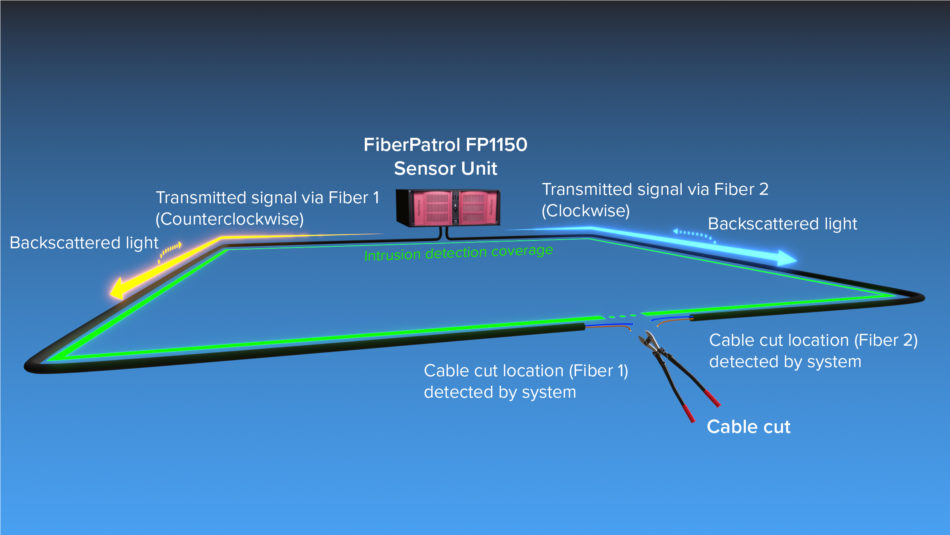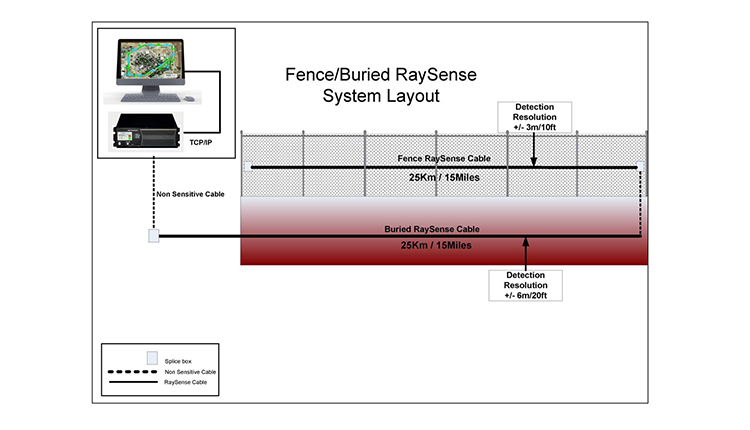The Ultimate Guide to Fiber Optic Protection Solutions for Your Company
In a period where safety problems are vital for businesses, comprehending the details of fiber optic technology can be transformative. This guide details exactly how integrating fiber optic safety systems not only boosts information protection but likewise uses advantages like resistance to disturbance and real-time monitoring capacities.
Recognizing Fiber Optic Modern Technology

The core of a fiber optic cable television is composed of a thin glass or plastic center, bordered by a cladding layer that reflects light back right into the core. fiber optic security system. This style guarantees very little loss of signal strength, even over extensive ranges. There are 2 primary kinds of fiber optic cords: single-mode and multi-mode. Single-mode fibers are made for long-distance transmission, while multi-mode fibers are suitable for much shorter distances, commonly utilized within structures.
Optical fiber are not just quicker yet additionally extra safe and secure than traditional wiring. Their inherent resistance to electro-magnetic interference and the difficulty of tapping right into the signal without discovery make them a recommended option for businesses focusing on data stability and safety and security. As companies progressively count on protected and effective communication systems, recognizing fiber optic modern technology comes to be vital for informed decision-making.
Trick Benefits of Fiber Optic Protection
When considering safety and security choices for a company, the benefits of fiber optic systems are especially compelling. Fiber optic technology uses outstanding information transmission speeds and bandwidth ability, making it ideal for handling high-resolution video clip feeds from surveillance cams. This capacity makes sure that security workers obtain real-time information, enhancing overall action times to possible safety dangers.
Furthermore, fiber optic wires are inherently immune to electro-magnetic interference, which can jeopardize the integrity of typical copper-based systems. This resistance makes sure that the information transmitted remains secure and continuous, giving a more reputable safety framework. Furthermore, fiber optics are less at risk to physical damages, as they are made from glass as opposed to metal, decreasing upkeep prices and downtime.
Fiber optic systems provide enhanced cybersecurity attributes, consisting of encryption abilities that secure sensitive information from unauthorized gain access to. Collectively, these advantages make fiber optic safety and security systems a durable option for organizations looking for to boost their safety and security measures.
Setup Refine and Factors To Consider
Taking into consideration the intricacies included, the installment procedure of fiber optic safety systems requires cautious planning and execution. The first action entails a detailed site analysis to identify ideal areas for cabling and devices. This assessment should take into consideration ecological variables, existing infrastructure, and potential susceptabilities.

Furthermore, the installation has to adhere to regional building ordinance and market requirements. This may include coordinating with various stakeholders such as building supervisors, IT groups, and safety workers to guarantee seamless assimilation with existing systems.
Post-installation, extensive screening is needed to verify system efficiency and recognize any kind of problems that might arise. By focusing on these considerations during the setup procedure, organizations can make sure a robust and reliable fiber optic safety system that satisfies their particular safety and security needs.
Most Recent Technologies in Fiber Optic Safety And Security
Current improvements in fiber optic modern technology have dramatically improved the capabilities of safety and security systems for services. One of one of the most noteworthy developments is the integration of fiber optic sensors that can reference find vibrations and intrusions along the boundary of a center. These sensing units supply real-time surveillance, enabling rapid reaction to prospective breaches.
In addition, the development of dispersed fiber optic sensing technology enables the continuous monitoring of huge areas with a solitary fiber wire. This method not just lowers installment expenses but likewise improves the integrity of keeping an eye on systems by getting rid of the need for numerous, different sensors.
Moreover, innovations in multiplexing techniques have enabled services to transfer vast quantities of information over fiber optic networks, boosting the abilities of video surveillance systems. High-definition video feeds can now be sent out over fars away without loss of top quality, making sure that security workers have access to clear and actionable information.
Last but not least, using artificial knowledge (AI) in conjunction with fiber optic systems is transforming threat discovery. AI algorithms can evaluate data from fiber optic networks to determine unusual patterns or actions, enabling for aggressive security measures. These advancements jointly represent a substantial jump onward in fiber optic safety and security modern technology.
Picking the Right System for Your Business
Choosing the suitable fiber optic security system for your organization is crucial for ensuring ideal defense and peace of mind. To make an informed choice, assess your certain safety demands, considering elements such as the size of your properties, the nature of your operations, and prospective susceptabilities.
Begin by evaluating the degree of safety and security required; as an example, high-risk atmospheres may require innovative systems with integrated security and invasion detection capacities. Next, consider scalability; as your company grows, your safety and security system ought to can broadening to accommodate boosted demands without substantial overhauls.
Furthermore, investigate the dependability and performance of different systems. Try to find providers with recognized track records and consumer endorsements that prove to their go to the website solution top quality. It's additionally a good idea to make inquiries about the technology's compatibility with existing facilities, making certain a smooth combination procedure.
Verdict
Finally, fiber optic protection systems offer a robust remedy for boosting organization protection facilities. The integration of high-speed information transmission, resistance to electromagnetic interference, and progressed monitoring capacities considerably enhances i was reading this general defense (fiber optic security system). By comprehending the innovation, recognizing its benefits, and thinking about the installment procedure, companies can make informed decisions. The most recent advancements even more reinforce the effectiveness of these systems, guaranteeing that companies stay safe and secure and versatile in an ever-evolving danger landscape.